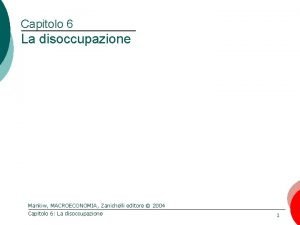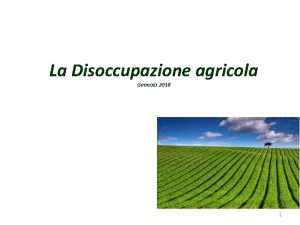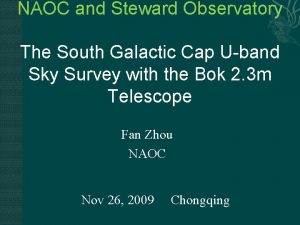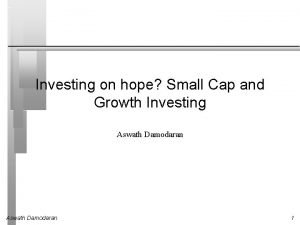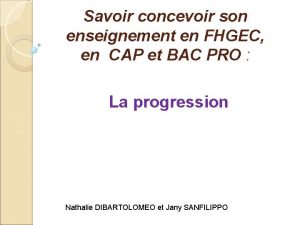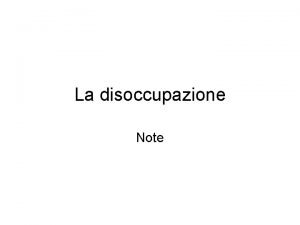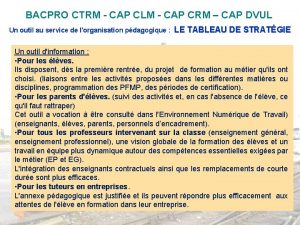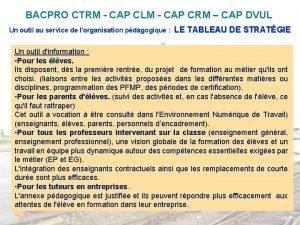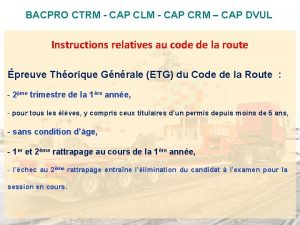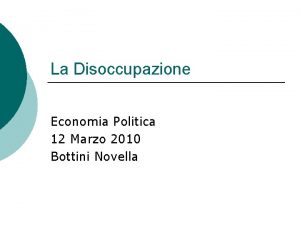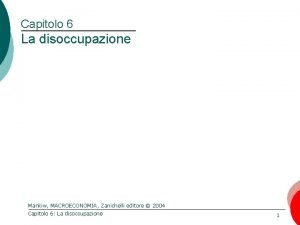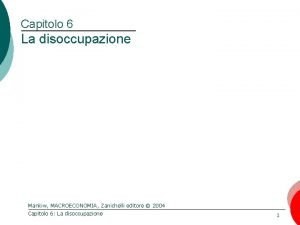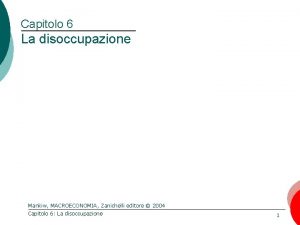CAP 6 WW ES disoccupazione CAP 7 PPmax
































- Slides: 32

CAP 6 W>W* (ES, disoccupazione) CAP 7 P=Pmax (profitto, rendita, no S) CAP 8 P=MC (breve periodo, Paretoefficienza, esaurimento guadagni dello scambio, D e S) CAP 11 P=MC=Acmin (lungo periodo, ∏=0; MES, efficienza tecnica)

DINAMICA DEI MERCATI: Δ ENDOGENE/Δ ESOGENI EQUILIBRIO/DISEQUILIBRIO BREVE/LUNGO ANALISI GENERALE/PARZIALE *point: prezzi come indici di scarsità (Hayek → prezzi come segnali, estrazione info nascosta, risparmio nella trasmissione info rispetto a economia pianificata)

1. STATICA COMPARATA Spostamenti DELLE curve di D e S ≠ da spostamenti LUNGO D e S (aggiustamento verso eq) ∆ delle determinanti esogene di D (preferenze) e S (tecnologia)


∆ nelle preferenze ↑ D (spostamento vs dx) Per ogni P, ↑ Q domandata S nn si sposta Nel nuovo eq ↑ P e Q


∆ tecnologico (↓ MC) ↑ S (spostamento vs dx) Per ogni P, ↑ Q offerta D nn si sposta Nel nuovo eq ↑ Q e ↓ P

Naturalmente, se ↓ D (spostamento verso sx), ↓ P e Q se ↓ S (spostamento verso sx), ↑ P e ↓ Q

*ESEMPIO: MERCATO DEL PETROLIO OFFERTA: OPEC, NN OPEC rigida per OPEC, rigida nel breve per nn OPEC, più elastica nel lungo (investimenti in nuova capacità produttiva) DOMANDA: rigida nel breve, più elastica nel lungo (sviluppo di alternative)

2008 inizio crisi 1979 -80 finanziaria alobaale II shock petrolifero 120. 000 1990 120 1918 Fine 1945 I Guerra II Guerra mondiale Fine 1973 -74 I shock petrolifero Dissoluzione Unione Sovietica 100 8 0 1929 inizio della Grande Depressione 60. 000 6 0 4 0 2 0 P r e z z o p e r b a r i l e , P ( $ 2 0 1 4 p e r b a r i l e ) 140 0 30. 000



↑ SHOCK DAL LATO DELL’OFFERTA (guerre, o nuovi giacimenti) SHOCK DAL LATO DELLA DOMANDA (crescita economica, nuove fonti di energia) ↓


2. LIBERTA’ d’ENTRATA e ZERO PROFIT CONDITION (breve/lungo)



* MERCATI FINANZIARI Es. di mkt perfettamente competitivi I prezzi cambiano costantemente e dipendono da PROFITTABILITA’ FUTURA e DA QUELLO CHE SI PENSA FARANNO GLI ALTRI (*Keynes, concorso di bellezza)

*VALORE ATTUALE: 100 €, t. i. 3% → a t+1 ho 103 € quanto valgono oggi 100 € a t+1? 100/1. 03= 97. 09 **SHORT SELLING (prevedo una discesa dei prezzi): prendo a prestitoli, li vendo subito e li ricompro per restituirli quando il prezzo è sceso → faccio soldi senza averne e senza avere mai realmente i titoli

3. PREZZI CONTROLLATI (mercato nero o secondario, affitti, salario minimo)


Razionamento, code, lotterie Mercato nero, bagarinaggio *anche per i mercati valutari (Venezuela)


↑ D ma P è fisso (controllato) ED, P ≠ da P* (mkt clearing) RENDITE (subaffitti; razionamento) SOLUZIONE: ↑S (equità/dotazioni) salario minimo: w>w* → ES (disoccupazione) potere di contrattazione, xò (mkt nn perfettamente competitivi)

4. RENDITE (SCHUMPETER: ‘sintomo dell’imperfezione’ →profitto, rendita da innovazione) di equilibrio di disequilibrio (impostazione libro: imperfezioni come caso generale, perfezione come caso particolare, invece che il contrario)

DI DISEQUILIBRIO: (i) pescatori in Kerala → ED, ES (ii) profitto del mercato del pane → p=MC >AC min (iii) vincoli politici e tecnologici nel mkt del petrolio (iv) speculazione nei mkt finanziari (v) mercati controllati e mercati secondari

DI EQUILIBRIO (p. 413) (i) da contrattazione (cap. 4, 5) (ii) da occupazione (cap. 6, 9) (iii) da monopolio (cap. 7) (iv) indotta dal governo (cap. 11) *surplus del cons e del prod. ? Solo in equilibrio parziale, quando l’alternativa è nn comprare o nn vendere il bene In EEG NO RENDITE (rend. fatt. = in usi alt. )

UNIT 8. SUPPLY AND DEMAND : PRICE TAKING AND COMPETITIVE MARKETS Photo : Abhijit Kar Gupta

T 8. 1 Price-taking firms You are given that the market demand curve of the good in concern is downward-sloping. Based on this information, which of the following statements is correct regarding a price-taking firm? Select one answer a. The demand curve faced by the firm is downward-sloping. b. The firm chooses the price that equals its marginal cost. c. The firm chooses its output where the marginal cost equals the price. Section 8. 3 d. A price-taking firm cannot be profit-maximising.

Select one answer T 9. 1 Friedrich Hayek Which of the following statements is correct? According to Friedrich Hayek: a. Prices convey the scarcity of a good under a centrally planned economy. b. Perfect competition can be attained without activities such as advertising, undercutting and improving ("differentiating") the goods or services produced. c. The advantage of capitalism is that it provides the right information to the right people. d. A single central authority can Section 9. 0 collate and make use of the information available in the economy better than the market.

T 9. 2 Reaching a new equilibrium The following diagram depicts the competitive hats market before and after a demand shift. Based on this information, which of the following statements is correct? Select one answer a. After the demand fall, the market initially moves from A to E, before settling to the new equilibrium at F. b. At E, the sellers are on the short side of the market. c. At E, lowering the price to $7 results in a Nash equilibrium for the buyers and sellers. d. In the adjustment process from E to the new market equilibrium F, the sellers behave as price-makers while the buyers remain price-takers. Section 9. 1

T 9. 3 A price floor (minimum wage) The UK introduced a national minimum wage in 1998. Which of the following statements is correct regarding minimum wages? Select one answer a. A minimum wage is a form of price ceiling. b. The introduction of a minimum wage would always lead to a fall in the demand for labour by firms. c. A minimum wage would not lead to increased unemployment if it is set low enough. d. Instead of a minimum wage, the government can promote Section 9. 6 increased labour participation to encourage higher wages.
 Disoccupazione frizionale definizione
Disoccupazione frizionale definizione Scadenza disoccupazione agricola 2021 proroga
Scadenza disoccupazione agricola 2021 proroga Disoccupazione involontaria macroeconomia
Disoccupazione involontaria macroeconomia Golf handicap beregner
Golf handicap beregner Cap compas
Cap compas Fibroscan valori cap
Fibroscan valori cap Pemberian cap dinas pada surat diletakkan di sebelah ... *
Pemberian cap dinas pada surat diletakkan di sebelah ... * Gear terminology
Gear terminology Cap cul
Cap cul Model devíti polí čáp
Model devíti polí čáp Doğumun kardinal hareketleri
Doğumun kardinal hareketleri La princesa es malvada cap 19
La princesa es malvada cap 19 Chimica piu capitolo 14 soluzioni
Chimica piu capitolo 14 soluzioni Cap building systems
Cap building systems Rapport de stage cap
Rapport de stage cap Cap cuisine
Cap cuisine Cap form a5c
Cap form a5c Pvu announcements
Pvu announcements Poem come live with me and be my love
Poem come live with me and be my love Cap sense
Cap sense Ascxx
Ascxx Cap xix evangelho segundo espiritismo
Cap xix evangelho segundo espiritismo Galactic cap review
Galactic cap review Cap laboratory accreditation manual 2020
Cap laboratory accreditation manual 2020 Malcolm kyser
Malcolm kyser Dvul
Dvul Pinkerton cap3
Pinkerton cap3 Biakromial çap
Biakromial çap Damodaran
Damodaran Tableau progression annuelle français
Tableau progression annuelle français Cap sur la prévention
Cap sur la prévention Cosmos db consistency levels
Cosmos db consistency levels Personaggi capitolo 5 promessi sposi
Personaggi capitolo 5 promessi sposi
